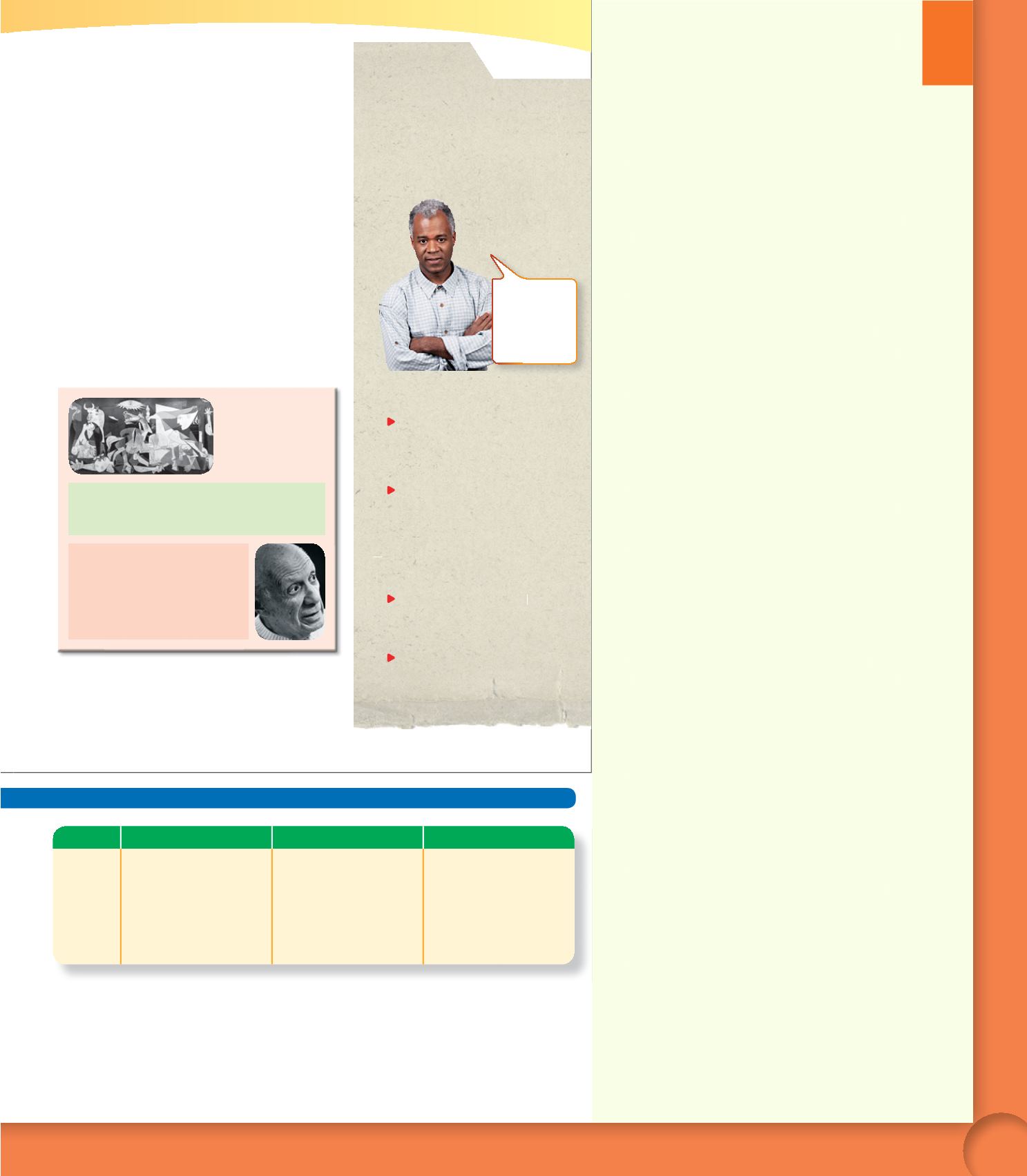

119
PASO 3
Amplía la información
r
Busca información sobre el
/
la autor(a) de la obra
y escribe una breve biografía. Busca también una foto
suya y varias imágenes de la obra que has elegido.
r
Investiga más sobre la obra elegida:
– ¿Qué representa? ¿A qué estilo artístico pertenece?
– Si es una pintura, ¿cómo se ha usado el color?
¿Y la luz?
– Si es una escultura o una construcción,
¿qué materiales se han empleado?
– ¿Qué relación tiene con su contexto geográfico,
artístico, económico, político, social o religioso?
PASO 4
Describe la obra
r
Escribe una descripción detallada de la obra y
explica lo que representa. Añade una breve
valoración personal.
PASO 5
Organiza la información
r
Reúne toda la información y prepara un póster.
Pablo Ruiz Picasso.
Guernica
(1937). Óleo sobre lienzo
(349,3 x 776,6 cm.). Museo
Reina Sofía (Madrid).
La obra:
El cuadro representa la crueldad de la guerra. A la izquierda hay
un toro, símbolo de la brutalidad. Debajo, una mujer llora con su hijo
muerto en brazos. En el suelo hay un hombre muerto con una espada
rota y una flor en la mano como un símbolo de esperanza.
El autor:
Pablo Ruiz Picasso. Málaga (España) 1881
– Mougins (Francia) 1973.
Pintor, dibujante y escultor. Inició su aprendizaje
en el mundo de la pintura a través de su padre,
profesor de Bellas Artes. Es uno de los grandes
maestros del siglo
XX
y uno de los creadores del
movimiento cubista.
PASO 6
Monta la exposición
r
Reúnan todos los pósteres elaborados por la clase
y monten la exposición. Expliquen las obras a los
visitantes y contesten sus preguntas.
Autoevaluación
¿Qué has aprendido en esta
unidad?
Haz estas actividades para comprobar
tu progreso.
a.
¿Puedes describir y comparar obras
de arte?
Describe tu cuadro favorito y
compáralo con otro que conoces.
b.
¿Puedes opinar y hacer valoraciones
sobre esculturas y construcciones?
Escribe tu opinión sobre el edificio
de tu escuela. ¿Qué te parece más
interesante o sorprendente desde
el punto de vista arquitectónico?
c.
¿Puedes dar consejos y
recomendaciones sobre obras
literarias?
¿Cuáles son tus tres libros
favoritos? Explica por qué te gustan
y haz un resumen del argumento de
uno de ellos.
Recomiéndale un libro a un(a)
amigo( ) a para que lo empiece a leer
este fin de semana. Explica por qué
crees que le gustaría.
U
n
id
a
d
6
% , #$"
"
!
$ #
$'
" #
! # ! *"
Unit
6
Paso 2
.
Using 4” x 6” index cards, have students create
an “ID Card” for their chosen work of art. They
may wish to put a border around it. Explain that
this will be their label for the poster, just like the
labels used in museums to identify the different
works of art.
Paso 3
.
Ask students to try to get as much information
as they can about their work of art. Then, they
should carefully decide what is relevant and
interesting enough to be included in the poster.
Paso 4
.
Emphasize the importance of including detailed
and vivid descriptions. Students may also want to
briefly speculate about the meaning of the work in
their personal critique.
Paso 5
.
Encourage students to try to achieve a good mix of
text and images, as well as attractive formatting.
Paso 6
.
Suggest to students that they prepare index
cards with additional information about their
chosen artist and work of art to be prepared for
questions from the public.
Evaluation
.
Distribute copies of the rubric to students.
Discuss the evaluation criteria and explain how
this project will be graded. Encourage students to
refer to the rubric as they prepare their projects.
Content
.
Encourage students to include original comments
and analyses in their descriptions. Remind them
that they should use precise art terminology.
Organization
.
Remind students to keep in mind the importance
of headings and captions when organizing the
different sections and images of their posters.
Presentation
.
Encourage students to ask good questions
and to be thoughtful listeners. Stress that the
conversations should stick to art topics.
Las obras de arte favoritas
PROYECTO
Content
Organization
Presentation
5 points Relevant, focused, and
interesting information.
Vivid sensory
details and striking
descriptions.
Time is used wisely.
Information is clearly
organized. Very
attractive formatting and
excellent choice
of images.
Clear and fluent
communication. Very
motivating, upbeat
delivery. Correct and
complete vocabulary
and grammar.
351
Book 4 Unit 6


















